Disney DVD's and Videos: Waly Disney Treasures |
Walt Disney created some of the most popular characters of all time. Here are some of the DVDs available through Amazon.com or their partners. If you wish to purchase any of these items, click on either the title or the cover to be directed to Amazon.com.
Please Note: Many of these videos and DVDs have been taken out of circulation by the Walt Disney Company. In most cases, Amazon.com's affiliates will still have copies available even after Amazon.com has used up their supply. Simply click through the cover, title name, or format, and continue to the page containing the video/DVD description.
If this website came up without frames, click here to see the complete website with frames.
For children's books featuring Mickey Mouse, go to the Mickey Mouse Books Page.
More Pages of Interest:
Disney Videos and DVDs ...





















And More ...





























For children's books featuring Mickey Mouse, go to the Mickey Mouse Books Page.
More Pages of Interest:
Disney Videos and DVDs ...





















And More ...





























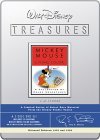
Walt Disney Treasures - Mickey Mouse in Living Color (1937) Format: DVD |
During the mid-'30s, Mickey Mouse's fans ranged from the more than one million children who were members of the Mickey Mouse Club to Franklin Roosevelt, Mary Pickford, and the Nizam of Hyderabad; theater marquees announced "A Mickey Mouse Cartoon" with the feature titles. These wonderful shorts, many of which have never been released to the home market, remind viewers just how charming Mickey was before his popularity and role as a corporate symbol restricted his behavior. In these cartoons Mickey's personality was boyish, appealing, and slightly mischievous. The superb animation emphasizes that impish appeal. When Mickey dances with a deck of cards in "Thru the Mirror," he displays a stylish grace Fred Astaire might envy; in "Brave Little Tailor," his expressions and body language reveal his thoughts as he outwits Willie the Giant. It's virtually impossible to watch him without smiling. These shorts overflow with color and motion, and their lavish visuals pack an increased impact in an era of minimal television animation. Only Walt Disney would spend the money to animate a full deck of cards, a band flying through the air in a tornado, or a clutch of semitransparent ghosts, and only his animators could make those characters live on the screen. The prints have been lovingly restored without pumping up the color too much: the nuances of the delicate watercolor backgrounds still come through. Parents, Disney buffs, and animation fans will want this superb collection in their home libraries. A collection of twenty-six animated shorts in color starring everyone's favorite, Mickey Mouse, released between 1935 and 1938. Introduction by Leonard Maltin. Cartoons:
|
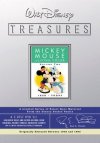
Walt Disney Treasures - Mickey Mouse in Living Color Part 2 (1937) Format: DVD |
The celebration of Mickey's color capers continues in this second volume of shorts -- from "Society Dog Show" in 1939 to his last short, "The Simple Things," in 1953 -- and feature film appearances, giving you a decidedly colorful history of the most famous mouse in the world. This outstanding review of Mickey's color career spotlights some very special features, including his groundbreaking performance in "The Sorcerer's Apprentice." You'll also get an inside look at Mickey's recent career through the eyes of his most recent animators, Mark Henn and Andreas Deja, and voice actors Wayne Allwine (Mickey) and Russi Taylor (Minnie). Featuring exclusive introductions by film historian Leonard Maltin, this is a timeless collection from generations past for generations to come. Includes:
|

Walt Disney Treasures - Mickey Mouse in Black and White Format: DVD |
In these cartoons released between 1928 and 1935, Walt Disney created one of the icons of 20th-century culture. Disney's reputation was built on these early shorts, and the films shimmer with the energy of the young artists exploring the new medium of the sound cartoon. Watching the films in chronological order enables the viewer to see the remarkable progress Walt and his crew made in animation, storytelling, and acting in just seven years. The rambunctious, rubbery Mickey of "Plane Crazy" and "Steamboat Willie" quickly developed into the polished charmer of "Gulliver Mickey" and "Mickey's Orphans." More than 70 years after his debut, the black and white Mickey still displays the appeal that made him so popular during the '30s, when A Mickey Mouse Cartoon appeared on theater marquees with the feature titles, and his fans included Franklin Roosevelt, Mary Pickford, George V of England, the Nizam of Hyderabad--and the more than one million children who joined the first Mickey Mouse Club. Although it's fun to look at the old sketches and pencil tests, the high point of the supplementary material is the discussion host Leonard Maltin conducts with Frank Thomas and Ollie Johnston, the last surviving members of the justly celebrated "Nine Old Men" of Disney animation. Thomas and Johnston were nearly 90 at the time of the interview, but their enthusiasm for their work, for Mickey, and for the man who made it all possible remains undimmed. (Unrated; suitable for all ages: cartoon violence) Includes:
|
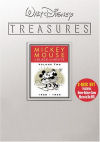
Walt Disney Treasures - Mickey Mouse in Black and White, Volume 2 Format: DVD |
By the time "The Barn Dance" (1928), the fourth Mickey Mouse short and the oldest film on this collection, was released, Mickey was well on his way to cartoon stardom. The viewer can see how quickly the Disney animators improved between "The Barn Dance" and "Mickey's Kangaroo" (1935, his last black-and-white film). The characters are so rubbery in "Barn Dance," that when Mickey steps on Minnie's foot, her leg stretches out on the floor. Mickey and Minnie look noticeably more solid by "Mickey's Mechanical Man" (1933). "Playful Pluto" (1934) offers the landmark sequence of Pluto trying to escape from sheet of fly paper: one of the first instances where an animated character actually seemed to think and react to his environment believably. But it's Pluto who gets the laughs--Mickey is already turning into the straight man he eventually became. The Disney shorts also improved as films during this period. The direction becomes surer, with increasingly imaginative camerawork. If some cartoons look backward, recycling gags from "Steamboat Willie," "The Barnyard Concert" (1929) anticipates "The Band Concert" (1935). In both films, Mickey conducts a group of ragtag musicians in Zampa's "The Poet and the Peasant" Overture, and "Barnyard Concert" feels like a rough sketch for the brilliant "Band Concert," Mickey's first color short. A few of these films include ethnic imagery that was considered good taste in the early '30s, but is no longer acceptable, as host Leonard Maltin cautions. (Unrated, suitable for ages 6 and older: cartoon violence, tobacco use, ethnic stereotypes) Includes:
|
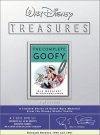
Walt Disney Treasures - The Complete Goofy (1944) Format: DVD |
With a gentle, childlike innocence, Goofy has delighted audiences for 70 years. For the first time ever, celebrate Walt Disney's lumbering, lovable, and eternally loyal everyman in this retrospective of his classic animated shorts and enjoy the heyday of one of the most popular characters in cartoon history. Unlike the rest of Disney's "mouse pack," Goofy didn't become a major movie star overnight. This compilation of shorts begins with the Goof's first starring role. The volume also includes animator Art Babbitt's original descriptive reference of all things Goofy, the original voice behind the Goof, Pinto Colvig, and an exclusive interview with the current voice of Goofy, Bill Farmer. You'll also have the opportunity to see theatrical posters and other memorabilia, a selection of story drawings, and background paintings. After all, it's the Goofy thing to do. Featuring exclusive introductions by film historian Leonard Maltin, this is a timeless collection from generations past for generations to come. In Stand By Me (1986), one of the boys asks, "If Mickey is a mouse and Donald is a duck, what's Goofy?" The answer: he's a dog. Originally named Dippy Dawg, the Goof, as the animators called him, made his debut as an obnoxious hayseed in "Mickey's Revue" (1932). This generous collection includes 46 of the 48 shorts that starred Goofy between 1939 and 1961 (but none of the great Mickey-Donald-Goofy films from the mid-'30s). The "How to Ride a Horse" sequence in The Reluctant Dragon (1941) set the pattern for many of these cartoons. An elegant narrator (artist John Ployardt) explains a sport that Goofy attempts to demonstrate. The character that animator Art Babbitt described in a 1935 lecture (quoted in the DVD bonus material) as an easygoing dimbulb gave way to an enthusiastic but spectacularly maladroit figure. One of the funniest entries in the series, "Hockey Homicide," contains several studio in-jokes: dueling stars Icebox Bertino and Fearless Ferguson, and referee Clean-Game Kinney are named for artists Al Bertino, Norm Ferguson, and director Jack Kinney. During the '50s, Goofy was transformed into a genial suburban Everyman in such domestic sitcoms as "Fathers Are People," "Two Weeks Vacation," and "Father's Day Off." The animators reduced his floppy ears and buck teeth, improved his posture, and gave him a brisker walk. The best-known short from this period is "Motor Mania" (1950), a mildly didactic spoof of American behavior on the road that was shown in driver's education classes for decades. Includes:
|
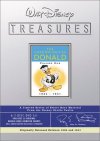
Walt Disney Treasures - Chronological Donald (Volume 1) Format: DVD |
It was 1934 when the irascible Donald Duck came to life in a teeny bit of a part in "The Wise Little Hen" and proceeded to steal the show. From that point on nobody could hold him back, and the much loved cranky character went on to be the most prolific of Walt's "fabulous five." Now for the first time, you can enjoy the Donald in all of his solo starring shorts from "Donald And Pluto" in 1936 to "Chef Donald" in 1941. This volume also includes a loving tribute to the man who achieved immortality by inventing the voice of Donald Duck -- and performing as his alter ego for 50 years -- Clarence "Ducky" Nash. Featuring exclusive introductions by film historian Leonard Maltin, this is a timeless collection from generations past for generations to come. . |
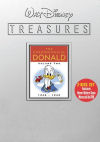
Walt Disney Treasures - Chronological Donald Volume 2 (1942-1946) Format: DVD |
Includes:
|

Walt Disney Treasures - Chronological Donald Volume 3 (1947-1950) Format: DVD |
Includes:
Bonus features include a retrospective of Donald's movie cameos and an interview with Ruben Procopio, a Disney character sculptor. Like the other Treasures box sets, these tins are individually numbered, come with a certificate of authenticity and come with a collectible lithograph, this time a reproduction of the poster art for 1948's "Inferior Decorator." Also like before, the discs are hosted by film historian Leonard Maltin. |

Walt Disney Treasures - The Complete Pluto, Volume One Format: DVD |
Includes:
|
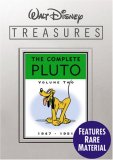
Walt Disney Treasures - The Complete Pluto, Volume Two Format: DVD |
Mickey's best pal Pluto continues to light up the screen as leading dog in more of his adventure-filled cartoons. Putting the spotlight on his comical antics from 1947 through 1951, this volume includes the inspired "Bone Bandit" of 1948 and the 1951 classic "Plutopia." The treats continue with three rarely seen shorts featuring Pluto's feline nemesis Figaro, and a revealing exploration of a classic Pluto short. Plus, contemporary Disney master animators discuss their favorite Pluto moments and the art and craft behind them. It's no wonder Mickey's faithful pup became top dog around the world. Featuring exclusive introductions by film historian Leonard Maltin, this is a timeless collection from generations past for generations to come. |
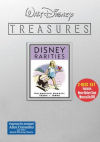
Walt Disney Treasures - Celebrated Shorts, 1920s - 1960s (Disney Rarities) Format: DVD |
Includes:
|
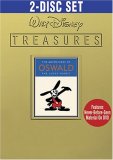
Walt Disney Treasures - Oswald the Lucky Rabbit Format: DVD |
|
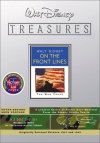
Walt Disney Treasures - On the Front Lines Format: DVD |
On December 8, 1941, the Disney Studio was taken over by the military as part of the war effort. Making the most of the talent that hadn't shipped out yet, Walt Disney spent the next four years creating and producing training, propaganda, and educational films for the Armed Forces. In addition to these films, this extraordinary volume also includes the full-length feature "Victory Through Air Power." Released theatrically in 1943, this powerful propaganda film has never been reissued until now. You'll also see recently discovered on-the-set footage, and get rare firsthand accounts about the work and culture at the Disney Studio in interviews with Disney Legends Joe Grant, John Hench, and Roy Disney. Featuring exclusive introductions by film historian Leonard Maltin, this is a timeless collection from generations past for generations to come. Includes the cartoons:
|

Walt Disney Treasures - Silly Symphonies (1934) Format: DVD |
In 1928, when Walt Disney's artists completed "The Skeleton Dance," the distributor of the Mickey Mouse shorts rejected the first "Silly Symphony" with a two-word telegram: "MORE MICE." Disney arranged to screen "Skeleton Dance" at the Carthay Circle Theater in Los Angeles, where it received an enthusiastic response, and the series took off. Seven "Silly Symphonies" won Academy Awards, beginning with "Flowers and Trees." Disney used these musically themed shorts to train young artists and test new styles, effects, and technologies: every film represented an innovation of some sort. In "Three Little Pigs," characters who looked alike demonstrated different personalities through the way they moved. "The Old Mill" showcased the newly invented Multiplane camera. The Sugar Cookie Girl in "Cookie Carnival" was one of several female characters the artists created while learning to animate a believable heroine for Snow White and the Seven Dwarfs. The well-chosen selections in this set demonstrate how quickly Disney advanced the art of animation during the '30s. Only eight years separate the crude black-and-white version of "The Ugly Duckling" (1931) from the moving Technicolor Oscar-winner of 1939. Over 60 years later, these films have lost none of their charm. The jazz-dancing insects in "Woodland Café," the wonderfully animated caricature of Mae West in "Who Killed Cock Robin," and the instrument-characters in "Music Land" remain as delightful as ever. Leonard Maltin makes a genial host, and two hidden cartoons include Walt's introductions from the old Disneyland program. |
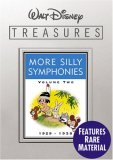
Walt Disney Treasures - More Silly Symphonies (1929-1938) Format: DVD |
|
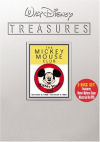
Walt Disney Treasures - Mickey Mouse Club Format: DVD |
"M-I-C-K-E-Y-M-O-U-S-E." Before the theme song's memorable spelling became an audio icon, before the series even aired, the Mickey Mouse Club was the most anticipated children's programming ever. This volume features the five episodes of week one of the black-and-white series that launched a television revolution. Also showcased in this volume is a wonderful tribute to the unforgettable Jimmie Dodd, the singer-actor who hosted the show. You'll also see recently discovered, never-before-seen color archival footage of the Mousketeers' very first appearance at the grand opening celebration of Disneyland. And you'll meet six original Mouseketeers in a reunion on the soundstage where they first got together in 1955. So, sit back and enjoy -- and you don't have to wait until 5:00. |

Walt Disney Treasures - The Adventures of Spin & Marty (The Mickey Mouse Club) Format: DVD |
Includes:
|
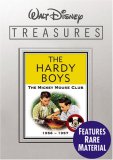
Walt Disney Treasures - The Mickey Mouse Club Featuring the Hardy Boys Format: DVD |
|

Walt Disney Treasures - Your Host, Walt Disney Format: DVD |
More than a time-capsule treasure for Disney buffs, this two-disc set will warm the nostalgic hearts of baby boomers who eagerly looked forward to their weekly visits with "Uncle Walt" Disney. As the host of his anthology series, Disneyland (later Walt Disney Presents, then The Wonderful World of Color), Disney presented classic cartoons and original programs, but he also gave starry-eyed viewers a privileged, behind-the-scenes look inside his magic kingdom, from the construction of his magnificent theme park to animators at work. Disneyland transformed Disney into the face of Disney Studios, a pied piper, according to film historian Leonard Maltin, who introduces the features on each disc. This collection of episodes features Disney at his most avuncular. "Where Do the Stories Come From" (1956) is a fun exploration of where Disney artists find their inspiration. "Fourth Anniversary Show" (1951) charts the development of the Disney featurette, Peter and the Wolf, but then becomes a surprise-party musical extravaganza for Disney hosted by his Mouseketeers, and featuring appearances by Guy "Zorro" Williams and Fess "Davy Crockett" Parker. Long-thought lost, "Kodak Presents Disneyland '59," is a black and white kinescope recording of a live, 90-min. television special (compete with entertaining Kodak commercials featuring Ozzie and Harriet Nelson and sons) that serves to introduce three new attractions to Disneyland: the Nautilus submarine ride, the Monorail and the Matterhorn. Look for rising stars Clint Eastwood and Dennis Hopper among parade participants. "Backstage Party" (1961) is a visit to the set of Disney's production of Babes in Toyland, with appearances by the film's stars, including Annette Funicello, Ed Wynn, and Ray Bolger. "Disneyland 10th Anniversary" (1965), previously released on the now-out-of-print Disneyland U.S.A. set, introduces the Haunted Mansion, Pirates of the Caribbean, and It's a Small World rides, and shows how "space-age" technology was used to create the Enchanted Tiki Room. Disc 2's extras include a true rarity, a 1962 Cinemascope film presentation created to accompany a Disney Radio City Music Hall stage show. Another delight is "I Captured the King of the Leprechauns," a 1959 Disneyland episode tied to the release of the feature Darby O'Gill and the Little People (and included as a bonus feature on that DVD). This whimsical bit of blarney follows Disney to Ireland in search of "the little people." Movie tough guy Pat O'Brien sends him off with a charming song about leprechauns, just a small sample of these episodes' endearing and enduring hokey charms. |
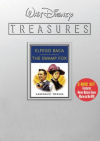
Walt Disney Treasures - Elfego Baca and The Swamp Fox (Legendary Heroes) Format: DVD |
|
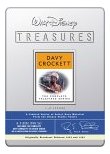
Walt Disney Treasures - The Complete Davy Crockett Televised Series Format: DVD |
All 5 episodes of Walt Disney's Davy Crockett series chronicling the adventures of the King of the Wild Frontier. Beginning with Davy Crockett, Indian Fighter and featuring Davy's adventures all the way up to the Alamo, these classic adventures are fun for the whole family. Introduction by Leonard Maltin. Episodes: Davy Crockett, Indian Fighter; Davy Crockett Goes to Congress; Davy Crockett's Keelboat Race; Davy Crockett and the River Pirates; Davy Crockett at the Alamo. Available uncut for the first time, the five episodes of Davy Crockett that aired on Walt Disney's "Disneyland" show (1954-55) launched one of the great pop culture crazes of the '50s. An estimated $300 million worth of Crockett merchandise was sold during the first eight months of the craze, including 10 million "coonskin" caps. Disney didn't spend a lot on the original episodes, but as host Leonard Maltin observes, the colorful location and matte shots distinguished Davy Crockett from the cheesy-looking westerns of the 1950s. The three original episodes were later recut into the theatrical feature Davy Crockett, King of the Wild Frontier (1955); the more comic adventures from the second season that introduced the flamboyant riverman Mike Fink (Jeffrey Hunter) became Davy Crockett and the River Pirates (1956). Tall and ruggedly handsome, if somewhat limited as an actor, Fess Parker was effective as the laconic frontiersman. The more experienced Buddy Ebsen (playing sidekick Georgie Russel) carried many of their scenes. Fifty years later, Davy Crockett remains an engaging example of national myth making. Younger viewers may be surprised to find this straightforward hero retains much of his appeal in an uncertain time. |
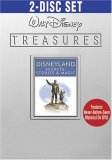
Walt Disney Treasures - Disneyland: Secrets Stories & Magic Format: DVD |
|
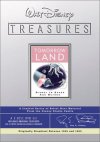
Walt Disney Treasures - Tomorrowland: Disney in Space and Beyond Format: DVD |
Walt Disney was a true visionary, and his most far-reaching vision examined the future. During the 1950s, his investigation into space exploration and the wondrous opportunities and challenges of space travel not only came alive in several Disneyland TV shows, but helped create strong public support for The United States space program. Go back in time to the beginning of the future and enjoy four episodes and a theatrical short that delve into the mysteries of the universe and space travel -- "Man In Space," "Man And The Moon," "Mars And Beyond," "Eyes In Outer Space," and "Our Friend The Atom." You'll also get a rare look at Walt's last film, "EPCOT," in which he reveals his concepts and plans for the Disney World and EPCOT projects. Other not-to-be-missed features include a special interview with noted futurist and author Ray Bradbury. Featuring exclusive introductions by film historian Leonard Maltin, this is a timeless collection from generations past for generations to come. |
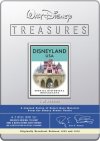
Walt Disney Treasures - Disneyland USA Format: DVD |
A special presentation of four Disneyland television specials - The Disneyland Story, Dateline Disneyland, Operation Disneyland, Disneyland After Dark - plus The Disneyland 10th Anniversary Show, all originally broadcast between 1955 and 1970, and hosted by Walt Disney himself. Also includes additional archival footage of Disneyland's opening day and other rare materials. Introduction by Leonard Maltin. To finance Disneyland he wanted to build, Walt Disney turned to the new medium of television. As host Leonard Maltin notes on this two- disc set of televised specials for the amusement park, Disney used the series to promote it, "and no one seemed to mind." ABC agreed to invest in return for a weekly one-hour program. The "Disneyland" TV show premiered on October 27, 1954: "Disneyland Story" introduced the park and its various lands, which would be the subject of future programs. The opening-day special, "Dateline Disneyland" (July 17, 1955), attracted an estimated audience of 90 million--virtually every television household in America. Hosted by Art Linkletter, Robert Cummings, and Ronald Reagan, the live broadcast includes such unplanned moments as Linkletter searching frantically for a microphone in Fantasyland. The Tenth Anniversary show (January 3, 1965) features cameos of Mary Blair and Marc Davis, two celebrated animation artists. Home movie footage of Walt pacing off distances at the barren site in Anaheim is intercut with peeks at forthcoming attractions. "Disneyland After Dark" (April 15, 1962) offers performances by Annette Funicello, Bobby Burgess, Bobby Rydell, Louis Armstrong, and a prepubescent quartet of Osmond Brothers. A must-have set for Disneyland buffs, Disney collectors, and nostalgic baby boomers. |
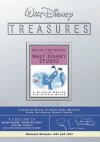
Walt Disney Treasures - Behind the Scenes at the Walt Disney Studio Format: DVD |
As Walt Disney's fame grew during the 1930s, people wanted to know more about his studio and how the "Silly Symphonies" and Mickey Mouse shorts were created. Although Disney seldom allowed visitors, he periodically offered viewers peeks inside into the studio through the films in this collection. In 1937, Disney made A Trip Through the Walt Disney Studios for his distributor, RKO, to help the marketing campaign for Snow White. This in-house documentary was later reworked and released as a trailer for the studio's first feature as How Walt Disney Cartoons Are Made. In 1941, humorist Robert Benchley toured the studio and chatted with the artists in The Reluctant Dragon. But the film was released during a bitterly fought strike that belied its cheerful depiction of the studio. During the '50s, Walt used his studio as a backdrop for several episodes of the Disneyland TV series. "The Story of the Animated Drawing" traces the history of the medium, including re-creations of Emil Reynaud's Théâtre Optique (1892-1900) and Winsor McCay's vaudeville routine with his landmark film Gertie the Dinosaur (1914). "Tricks of Our Trade," which focuses on the creation of Sleeping Beauty, shows staged footage of four of the celebrated "Nine Old Men"--Marc Davis, Milt Kahl, Frank Thomas, and Ollie Johnston--sketching. In the DVD bonus material, host Leonard Maltin traces the development of the studio facilities from a Los Angeles garage to its present location in Burbank. Maltin also chats with Disney legend Joe Grant, who cowrote the "Baby Weems" sequence in Reluctant Dragon. Recorded at the time of Grant's 94th birthday, the artist displays the sly wit that continues to inspire animators. |
Back to Home Page |
Still can't find what you're looking for? Search Amazon.com's database directly.
Call 1-800-THE-LOST |
NOTE: This website is a private site and is in no way associated with the Walt Disney Company. All sales through this website are made through Amazon.com.